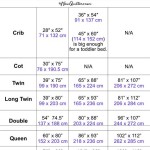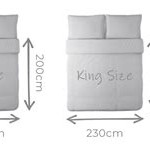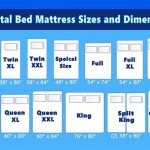Understanding Bed Sizes: A Comprehensive Guide to Twin, Full, Queen, and King
Choosing the right bed size is a crucial decision when furnishing a bedroom. It affects not only personal comfort but also the overall aesthetic and even the functionality of the space. With a wide range of options available, understanding the differences between common bed sizes is essential to making an informed choice. This guide explores twin, full, queen, and king-size beds, providing information on their dimensions, suitability for different needs, and considerations for layout and decor.
Twin-Size Beds: The Compact Option
Twin-size beds are the most compact option, measuring 39 inches wide and 75 inches long. They are typically ideal for children and teenagers, providing a comfortable sleeping space without taking up too much room. Twin beds are also popular in guest rooms, dorm rooms, or small apartments, making efficient use of limited space. Their compact size allows for flexibility in room arrangement, enabling the inclusion of additional furniture like desks, dressers, or bookshelves.
While twin beds offer a practical solution for smaller spaces, they might not be suitable for larger individuals or couples. Limited sleeping space can lead to discomfort, especially for taller or heavier individuals who may find the bed too narrow. Additionally, couples might find a twin bed too small for shared sleeping, leading to cramped conditions and potential disturbances.
Full-Size Beds: A Popular Choice for Singles and Smaller Couples
Full-size beds, often referred to as double beds, offer a larger sleeping surface than twin beds, measuring 54 inches wide and 75 inches long. They provide ample space for a single individual, comfortably accommodating a standard mattress and bedding without feeling cramped. Full-size beds are a popular choice for singles, teenagers, and even couples looking for a more compact option compared to larger bed sizes.
Full-size beds are generally considered a good compromise between space and comfort. They provide adequate sleeping space for one person while still being manageable in smaller bedrooms. However, for couples, a full-size bed might feel too small, especially if both individuals are larger or prefer more space to move around. Additionally, it can be challenging to fit two nightstands and other bedside furniture comfortably alongside a full-size bed.
Queen-Size Beds: The Standard for Most Couples
Queen-size beds are considered the standard for most couples, offering a generous sleeping surface of 60 inches wide and 80 inches long. This substantial size provides ample space for two individuals to sleep comfortably without feeling cramped, allowing for more freedom of movement and less disturbance to the sleeping partner. Queen-size beds are also suitable for individuals who value extra space and prefer a more luxurious sleeping experience.
Queen-size beds are versatile and can be incorporated into various bedroom layouts and styles. They provide a good balance between comfort and space, fitting well in larger bedrooms while still being manageable in smaller spaces. However, larger bedrooms might benefit from the extra spaciousness of a king-size bed, offering even more room for movement and relaxation.
King-Size Beds: The Ultimate in Luxury and Space
King-size beds are the largest and most opulent option, measuring 76 inches wide and 80 inches long. They offer unparalleled sleeping space, accommodating two individuals with ample room to move around comfortably. King-size beds are ideal for couples who value spaciousness and enjoy a luxurious sleeping experience. They are also perfect for families with children who occasionally join their parents in bed.
King-size beds are best suited for large bedrooms, allowing for ample space around the bed for furniture and movement. However, they might be too large for smaller bedrooms, creating a cramped and cluttered atmosphere. The substantial size of a king-size bed can also make it more challenging to change bedding and maneuver around the bed for cleaning.
Beyond Standard Sizes: California King and Eastern King
While the standard king-size bed is the most common large bed option, there are other variations worth considering. The California king, measuring 72 inches wide and 84 inches long, offers a longer sleeping surface than the standard king, ideal for taller individuals who find the standard length too short. The Eastern king, measuring 76 inches wide and 80 inches long, is slightly narrower than the standard king but offers the same length.
Choosing between these variations depends on individual needs, priorities, and available space. If length is a major consideration, a California king might be the best choice. However, if width is more important, a standard or Eastern king might be more suitable. It's important to consider these factors carefully when deciding on the best bed size for your needs.

Mattress Sizes Chart And Bed Dimensions Guide Amerisleep

Mattress Dimensions And Bed Sizes Pictograms Depict Icons Of People Sleeping On Diffe That Include Dimension Measurements For Crib Twin Xl Full Double Queen King Size Stock Vrgrafik

Mattress Size Chart Bed Dimensions 2024 Guide U S News

Mattress Sizes And Dimensions Guide Clarity

Twin Bed Size Dimensions Mattress Guide Nectar Sleep

Bed Sizes Guide Curtain Of Maine
Mattress Size Chart And Bed Dimensions Guide 2024

Mattress Sizes And Bed Dimensions Dimension Measurements For Crib Small Single Twin Full Or Double Queen King Size Diffe Line Icons Editable Stroke Vector Ilration Stock Vrgrafik Adobe

The Ultimate Mattress Size Chart And Bed Dimensions Guide Sleep Advisor

Mattress Sizes 101 Finding Your Perfect Fit
Related Posts







